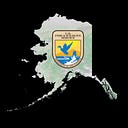All The Fish
Alaska Blackfish
The Arctic’s only air-breathing fish
Although rarely exceeding 8 inches in length, this tiny Esocid is arguably the hardiest of Alaska’s fish. Most notably, they’re the only air-breathing fish in the Arctic. In fact, only a few fishes in the world can breathe atmospheric oxygen. Thanks to a modified, gas-absorbing esophagus, the Alaska Blackfish can thrive where other fish can’t, like stagnant waters and seasonal tundra ponds. How neat is that?
Alaska Blackfish spend a lot of time on the bottom of lakes and ponds, where they pursue their prey — small aquatic insects and tiny crustaceans. In winter, when dissolved oxygen levels drop under the ice, they go to the surface to gulp air. When available, they take advantage of muskrat “pushups” — where muskrats pile vegetation on the surface of the ice over an opening for safe eating all winter long. The Blackfish gulp atmospheric oxygen from those holes to keep themselves alive through the winter, and may even help keep the holes open with the motion of their tiny fins.
Known in the Iñupiaq language as asiłuuqiñiq (translated to a dark-skinned bottom dweller) and in the Koyukon language as oonyeeyh (“the one you survive on”) the Alaska Blackfish has long been harvested by Alaska Native Peoples. In late winter when other fresh food sources are scarce, Alaska Blackfish are available. Subsistence fishermen catch them in funnel traps placed where they gather under openings in the ice to gulp air.
Legendary for their cold-hardiness, there are stories of Alaska Blackfish coming back to life after being frozen. Scientific studies have since shown they can’t survive being completely frozen, but they are extremely cold-hardy and can remain active under the ice in oxygen-poor lakes and ponds where other fish can’t survive.
In the geologic past, Alaska blackfish ranged over a broad area from eastern Russia to southcentral Alaska. A fossil specimen found in the Homer area shows that blackfish were once present on the Kenai Peninsula. In recent times, Blackfish occur naturally in eastern Russia and western, northern, and Interior Alaska.
Blackfish had long been absent from southcentral Alaska until they were transported to Anchorage in the 1950s. Later, they were transported intentionally or unintentionally to waters in the Palmer and Wasilla area, where they flourished. They were found in the 1990s on the Kenai Peninsula. Efforts to eradicate Alaska Blackfish where they had been introduced included using rotenone, a compound that interferes with respiration, but the air-breathing Blackfish persisted.
Alaska Blackfish don’t inhabit any other U.S. state, so if you want to catch one of these fish you’ll have to come here to the Great Land or visit Siberia!
Safety Tip
Alaska winters offer numerous opportunities for fishing out on the ice and it’s always fun to try out new spots. However, before setting foot on a new lake or river, talk to either friends or locals who are familiar with the area. Ice thickness often varies for numerous reasons including the presence of springs or currents. Lake outlets or outer bends often have thinner ice than the surrounding waters for these reasons. It’s a good idea for anglers new to any destinations to familiarize themselves with local knowledge from the area to stay both safe and dry.
Listen to our new podcast “Fish of the Week!” to learn more about Alaska Blackfish and all the fish.
Compiled by Katrina Liebich, Digital Media Manager for the U.S. Fish and Wildlife Service’s Alaska External Affairs, with excerpts from Matt Bowser’s Refuge Notebook article Alaska blackfish on the Kenai and conversations during Episode 3 of Fish of the Week: Alaska Blackfish. Big thanks to co-host and fish enthusiast Guy Eroh and guest, Luke Byker (a biologist with the Army Corps of Engineers based in Anchorage, Alaska):
In Alaska we are shared stewards of world renowned natural resources and our nation’s last true wild places. Our hope is that each generation has the opportunity to live with, live from, discover and enjoy the wildness of this awe-inspiring land and the people who love and depend on it.
As the Service reflects on 150 years of fisheries conservation, we honor, thank, and celebrate the whole community — individuals, Tribes, the State of Alaska, sister agencies, fish enthusiasts, scientists, and others — who have elevated our understanding and love, as people and professionals, of all the fish.
Follow us: Facebook Twitter fws.gov/alaska/
